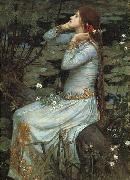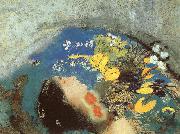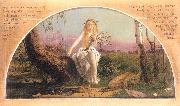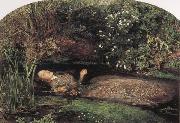
Oil On
Canvas, Real Flavor of Old Masters
|
John William Waterhouse
|
|||
|
|
|||
| English Pre-Raphaelite Painter, 1849-1917 English painter. His father was a minor English painter working in Rome. Waterhouse entered the Royal Academy Schools in London in 1870. He exhibited at the Society of British Artists from 1872 and at the Royal Academy from 1874. From 1877 to the 1880s he regularly travelled abroad, particularly to Italy. In the early 1870s he had produced a few uncharacteristic Orientalist keepsake paintings, but most of his works in this period are scenes from ancient history or classical genre subjects, similar to the work of Lawrence Alma-Tadema (e.g. Consulting the Oracle, c. 1882; London, Tate). However, Waterhouse consistently painted on a larger scale than Alma-Tadema. His brushwork is bolder, his sunlight casts harsher shadows and his history paintings are more dramatic. | |||
|
|
|||
|
|
Ophelia John William Waterhouse3.jpg Painting ID:: 448 Visit European Gallery |
1894 Private collection | |
Height Width |
INS/CM |
||
|
X |
|
||
|
|
|||
|
Odilon Redon
|
|||
|
|
|||
| French Symbolist Painter, 1840-1916 Bertrand-Jean Redon, better known as Odilon Redon (April 20, 1840 ?C July 6, 1916) was a Symbolist painter and printmaker, born in Bordeaux, Aquitaine, France. Odilon was a nickname derived from his mother, Odile. Redon started drawing as a young child, and at the age of 10 he was awarded a drawing prize at school. At age 15, he began formal study in drawing but on the insistence of his father he switched to architecture. His failure to pass the entrance exams at Paris?? Ecole des Beaux-Arts ended any plans for a career as an architect, although he would later study there under Jean-L??on Gerôme. Back home in his native Bordeaux, he took up sculpture, and Rodolphe Bresdin instructed him in etching and lithography. However, his artistic career was interrupted in 1870 when he joined the army to serve in the Franco-Prussian War. At the end of the war, he moved to Paris, working almost exclusively in charcoal and lithography. It would not be until 1878 that his work gained any recognition with Guardian Spirit of the Waters, and he published his first album of lithographs, titled Dans le R??ve, in 1879. Still, Redon remained relatively unknown until the appearance in 1884 of a cult novel by Joris-Karl Huysmans titled, À rebours (Against Nature). The story featured a decadent aristocrat who collected Redon's drawings. In the 1890s, he began to use pastel and oils, which dominated his works for the rest of his life. In 1899, he exhibited with the Nabis at Durand-Ruel's. In 1903 he was awarded the Legion of Honor. His popularity increased when a catalogue of etchings and lithographs was published by Andr?? Mellerio in 1913 and that same year, he was given the largest single representation at the New York Armory Show. In 1923 Mellerio published: Odilon Redon: Peintre Dessinateur et Graveur. An archive of Mellerio's papers is held by the Ryerson & Burnham Libraries at the Art Institute of Chicago. In 2005 the Museum of Modern Art launched an exhibition entitled "Beyond The Visible", a comprehensive overview of Redon's work showcasing more than 100 paintings, drawings, prints and books from The Ian Woodner Family Collection. The exhibition ran from October 30, 2005 to January 23, 2006. | |||
|
|
|||
|
|
Ophelia Odilon Redon14.jpg Painting ID:: 3345 Visit European Gallery |
1900/1905 The Ian Woodner Family Collection, New York | |
Height Width |
INS/CM |
||
|
X |
|
||
|
|
|||
|
Arthur Devis
|
|||
|
|
|||
| 1712-1787 English By 1728 he had left Preston, and the following year he was working in London for the Flemish topographical and sporting painter Peter Tillemans. There he specialized in landscape painting and copying various works in Tillemans studio after Marco Ricci, Giovanni Paolo Panini and Jan van Bloemen. Devis earliest known commission, Hoghton Towers from Duxon Hill, Lancashire (1735; priv. col., see 1983 exh. cat., no. 3), painted for Sir Henry Hoghton during a trip to Preston in 1734-5, shows Tillemans influence in its attention to detail and the use of thin, transparent paint. Thomas Lister with his Family (c. 1738; Chicago, IL, A. Inst.) demonstrates a similar interest in landscape, featuring the family group in Gisburn Park, Lancs. Devis had returned to London by 1742 and established himself as a painter of conversation pieces, with a studio in Great Queen Street. Roger Hesketh with his Family is typical of his work at this time; it shows how Devis transformed the intimacy of a Dutch 17th-century genre scene into an elegant interior with the group of sitters connected by formal, schematic gestures. Roger Hesketh stands apart, in a tastefully contrived pose, his legs crossed and right arm thrust inside his waistcoat. His son, Fleetwood, stands with his hand resting on a dog next to his wife, who is seated with an infant on her lap. The adjacent telescope, globe and marine paintings are intended to advertise Hesketh interest in astronomy and travel. | |||
|
|
|||
|
|
Ophelia new3/Arthur Devis_jc5cHz.jpg Painting ID:: 19092 Visit European Gallery |
1852, retouched 1857-58 Oil on panel. | |
Height Width |
INS/CM |
||
|
X |
|
||
|
|
|||
|
Sir John Everett Millais
|
|||
|
|
|||
| British 1829-1896 Sir John Everett Millais Galleries After his marriage, Millais began to paint in a broader style, which was condemned by Ruskin as "a catastrophe". It has been argued that this change of style resulted from Millais' need to increase his output to support his growing family. Unsympathetic critics such as William Morris accused him of "selling out" to achieve popularity and wealth. His admirers, in contrast, pointed to the artist's connections with Whistler and Albert Moore, and influence on John Singer Sargent. Millais himself argued that as he grew more confident as an artist, he could paint with greater boldness. In his article "Thoughts on our art of Today" (1888) he recommended Vel??zquez and Rembrandt as models for artists to follow. The Two Princes Edward and Richard in the Tower (1878) The Boyhood of Raleigh (1871)Paintings such as The Eve of St. Agnes and The Somnambulist clearly show an ongoing dialogue between the artist and Whistler, whose work Millais strongly supported. Other paintings of the late 1850s and 1860s can be interpreted as anticipating aspects of the Aesthetic Movement. Many deploy broad blocks of harmoniously arranged colour and are symbolic rather than narratival. Later works, from the 1870s onwards demonstrate Millais' reverence for old masters such as Joshua Reynolds and Vel??zquez. Many of these paintings were of an historical theme and were further examples of Millais' talent. Notable among these are The Two Princes Edward and Richard in the Tower (1878) depicting the Princes in the Tower, The Northwest Passage (1874) and the Boyhood of Raleigh (1871). Such paintings indicate Millais' interest in subjects connected to Britain's history and expanding empire. His last project was to be a painting depicting a white hunter lying dead in the African veldt, his body contemplated by two indifferent Africans. This fascination with wild and bleak locations is also evident in his many landscape paintings of this period, which usually depict difficult or dangerous terrain. The first of these, Chill October (1870) was painted in Perth, near his wife's family home. Many others were painted elsewhere in Perthshire, near Dunkeld and Birnam, where Millais rented grand houses each autumn in order to hunt and fish. Millais also achieved great popularity with his paintings of children, notably Bubbles (1886) ?C famous, or perhaps notorious, for being used in the advertising of Pears soap ?C and Cherry Ripe. | |||
|
|
|||
|
|
Ophelia new3/Sir John Everett Millais-958566.jpg Painting ID:: 27673 Visit European Gallery |
mk58 1851-2 oil on canvas 76.2x111.8cm Tate.London | |
Height Width |
INS/CM |
||
|
X |
|
||
|
|
|||










